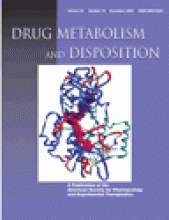Abstract
DB289 [2,5-bis(4-amidinophenyl)furan-bis-O-methylamidoxime] is biotransformed to the potent antiparasitic diamidine DB75 [2,5-bis(4-amidinophenyl) furan] by sequential oxidative O-demethylation and reductive N-dehydroxylation reactions. Previous work demonstrated that the N-dehydroxylation reactions are catalyzed by cytochrome b5/NADH-cytochrome b5 reductase. Enzymes responsible for catalyzing the DB289 O-demethylation pathway have not been identified. We report an in vitro metabolism study to characterize enzymes in human liver microsomes (HLMs) that catalyze the initial O-demethylation of DB289 (M1 formation). Potent inhibition by 1-aminobenzotriazole confirmed that M1 formation is catalyzed by P450 enzymes. M1 formation by HLMs was NADPH-dependent, with a Km and Vmax of 0.5 μM and 3.8 nmol/min/mg protein, respectively. Initial screening showed that recombinant CYP1A1, CYP1A2, and CYP1B1 were efficient catalysts of M1 formation. However, none of these three enzymes was responsible for M1 formation by HLMs. Further screening showed that recombinant CYP2J2, CYP4F2, and CYP4F3B could also catalyze M1 formation. An antibody against CYP4F2, which inhibited both CYP4F2 and CYP4F3B, inhibited 91% of M1 formation by HLMs. Two inhibitors of P450-mediated arachidonic acid metabolism, HET0016 (N-hydroxy-N′-(4-n-butyl-2-methylphenyl)formamidine) and 17-octadecynoic acid, effectively inhibited M1 formation by HLMs. Inhibition studies with ebastine and antibodies against CYP2J2 suggested that CYP2J2 was not involved in M1 formation by HLMs. Additionally, ketoconazole preferentially inhibited CYP4F2, but not CYP4F3B, and partially inhibited M1 formation by HLMs. We conclude that CYP4F enzymes (e.g., CYP4F2, CYP4F3B) are the major enzymes responsible for M1 formation by HLMs. These findings indicate that, in human liver, members of the CYP4F subfamily biotransform not only endogenous compounds but also xenobiotics.
Footnotes
-
This study was supported by grants from the Bill and Melinda Gates Foundation and the Medicines for Malaria Venture.
-
Article, publication date, and citation information can be found at http://dmd.aspetjournals.org.
-
doi:10.1124/dmd.106.010587.
-
ABBREVIATIONS: DB75, 2,5-bis(4-amidinophenyl) furan; DB289, 2,5-bis(4-amidinophenyl)furan-bis-O-methylamidoxime; DB289-d8, deuterium-labeled DB289; 17-ODYA, 17-octadecynoic acid; ABT, 1-aminobenzotriazole; P450, cytochrome P450; FMO, flavin monooxygenase; HLM, human liver microsome; HPLC, high performance liquid chromatography; LTB4, leukotriene B4; TAO, troleandomycin; HET0016, N-hydroxy-N′-(4-n-butyl-2-methylphenyl)formamidine; LC/MS/MS, liquid chromatography-tandem mass spectrometry.
-
↵1 James L. Allen, deceased.
- Received April 19, 2006.
- Accepted September 21, 2006.
- The American Society for Pharmacology and Experimental Therapeutics
DMD articles become freely available 12 months after publication, and remain freely available for 5 years.Non-open access articles that fall outside this five year window are available only to institutional subscribers and current ASPET members, or through the article purchase feature at the bottom of the page.
|






